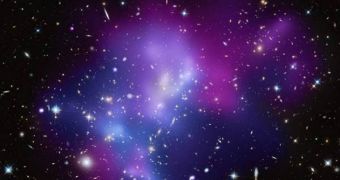In a recent collaboration between the Chandra X-Ray Observatory, the Hubble Space Telescope and the Keck Observatory in Hawaii, NASA was able to observe the largest galactic collision ever recorded, taking place some 5.4 billion light-years away from Earth. Four galaxies are involved in the pile-up, and studying them will undoubtedly offer more insight into the interactions that occur when galactic “cannibalism” events happen.
The collision takes place along the MACSJ0717 filament, a 13-million-light-year-long continuous stream of galaxies, gas, cosmic dust and, potentially, dark matter. This particular filament is channeling a large number of galaxies in an already vastly populated region of space, making such collisions imminent and also pretty spectacular. “In addition to this enormous pileup, MACSJ0717 is also remarkable because of its temperature. Since each of these collisions releases energy in the form of heat, MACS0717 has one of the highest temperatures ever seen in such a system,” Space quotes University of Hawaii Astronomer Cheng-Jiun Ma as saying.
According to existing knowledge in astronomy, the largest galaxies in existence have formed, or are about to do so following collisions between smaller ones. Our own Milky Way is said to have formed in this manner, as experts have discovered that it still bears the traces of a previous impact. In a few billion years, our galaxy will impact a massive gas cloud, and then it will eventually merge with the Andromeda galaxy, resulting in an even larger formation.
According to computer simulations, filaments play a crucial role in the emergence of massive galaxies. If two of them cross each other's path, then that point will most likely become the spawning place of a supermassive galaxy. Smaller ones, gas, dust and dark matter continuously flow along filaments, and if they meet at a “crossing,” then they merge and create incredibly large structures. “It's exciting that the data we get from MACSJ0717 appear to beautifully match the scenario depicted in the [computer] simulations,” Ma added.

 14 DAY TRIAL //
14 DAY TRIAL //